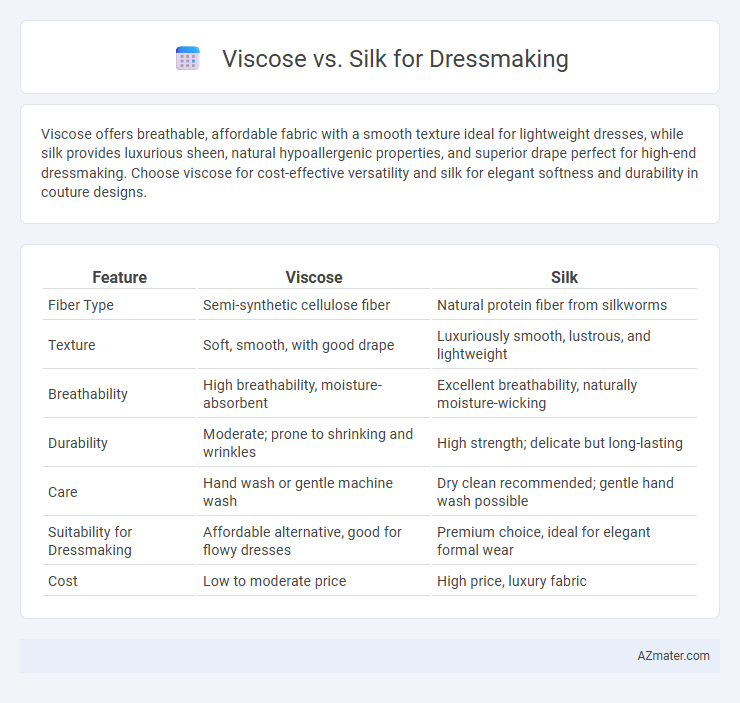Viscose offers breathable, affordable fabric with a smooth texture ideal for lightweight dresses, while silk provides luxurious sheen, natural hypoallergenic properties, and superior drape perfect for high-end dressmaking. Choose viscose for cost-effective versatility and silk for elegant softness and durability in couture designs.
Table of Comparison
| Feature | Viscose | Silk |
|---|---|---|
| Fiber Type | Semi-synthetic cellulose fiber | Natural protein fiber from silkworms |
| Texture | Soft, smooth, with good drape | Luxuriously smooth, lustrous, and lightweight |
| Breathability | High breathability, moisture-absorbent | Excellent breathability, naturally moisture-wicking |
| Durability | Moderate; prone to shrinking and wrinkles | High strength; delicate but long-lasting |
| Care | Hand wash or gentle machine wash | Dry clean recommended; gentle hand wash possible |
| Suitability for Dressmaking | Affordable alternative, good for flowy dresses | Premium choice, ideal for elegant formal wear |
| Cost | Low to moderate price | High price, luxury fabric |
Introduction to Viscose and Silk Fabrics
Viscose, a semi-synthetic fiber made from cellulose, offers a soft texture and excellent drape suitable for dressmaking, while silk, derived from silkworm cocoons, is renowned for its natural sheen and luxurious feel. Viscose provides breathability and affordability compared to silk, which is prized for its strength and elegance but tends to be more expensive and delicate. Both fabrics require specific care and handling techniques to maintain their appearance and durability in finished garments.
Key Differences Between Viscose and Silk
Viscose is a semi-synthetic fiber made from cellulose, offering affordability and breathability, while silk is a natural protein fiber known for its luxury, smooth texture, and superior strength. Viscose tends to wrinkle easily and requires careful washing, whereas silk boasts natural elasticity and durability but demands delicate care and dry cleaning. The moisture-wicking properties of viscose make it comfortable for warmer climates, contrasting with silk's natural temperature regulation, providing coolness in summer and warmth in winter.
Origins and Production Processes
Viscose, a semi-synthetic fiber derived from cellulose in wood pulp or cotton waste, undergoes a chemical-intensive process involving steeping, shredding, and treating with chemicals like carbon disulfide to create a versatile fabric. Silk originates from silkworm cocoons, produced through a natural process where larvae spin protein-based fibers, which are then carefully harvested, boiled, and reeled to preserve the fabric's smooth texture and luxurious sheen. The production of viscose emphasizes industrial-scale manufacturing and environmental considerations, whereas silk relies on traditional sericulture, demanding labor-intensive harvesting and meticulous processing.
Texture and Appearance Comparison
Viscose fabric offers a smooth, soft texture with a matte to semi-lustrous finish, mimicking silk's natural sheen but with less shimmering brilliance. Silk boasts a luxurious, glossy surface and a fluid drape that enhances the richness and elegance of dresses, providing vibrant color depth unmatched by viscose. While viscose is more affordable and breathable, silk's natural protein fibers give it superior strength and a silky, cool feel that elevates high-end dressmaking.
Comfort and Breathability Factors
Viscose offers a soft and smooth texture with excellent breathability, making it ideal for comfortable dressmaking in warm climates due to its moisture-wicking properties. Silk provides a luxurious feel and natural temperature regulation, allowing it to keep the wearer cool in summer and warm in winter, but it may lack the same breathability as viscose. Choosing between viscose and silk depends on balancing affordability and easy maintenance against natural fiber benefits and premium comfort.
Durability and Care Requirements
Viscose dresses offer moderate durability with susceptibility to weakening when wet, requiring gentle hand washing or dry cleaning to maintain fabric integrity. Silk, known for its luxurious texture and natural strength, demands careful handling with dry cleaning recommended to preserve its fibers and sheen. Both fabrics necessitate delicate care, but silk typically offers higher durability and longevity if properly maintained.
Cost and Affordability Analysis
Viscose offers a cost-effective alternative to silk in dressmaking, with prices significantly lower due to its synthetic production process, making it accessible for budget-conscious designers. Silk, a natural protein fiber, commands higher prices because of labor-intensive harvesting and processing, adding to its luxury appeal but limiting affordability. Choosing viscose balances aesthetic appeal and wearability, while silk remains a premium option valued for its natural sheen and durability despite the higher expense.
Environmental Impact: Sustainability of Viscose vs Silk
Viscose production involves significant chemical usage and deforestation risks, leading to concerns about its environmental sustainability, especially when sourced from non-certified forests. In contrast, silk is a natural protein fiber derived from silkworm cocoons, and though it requires intensive labor, its biodegradability and renewable nature often result in a lower overall ecological footprint. Sustainable silk production initiatives, such as organic or wild silk, offer improved environmental benefits compared to conventional viscose manufacturing methods.
Ideal Dressmaking Uses for Each Fabric
Viscose excels in dressmaking for its breathable, lightweight, and drapey qualities, making it ideal for flowy summer dresses, casual wear, and garments requiring fluid movement. Silk, prized for its luxurious sheen and smooth texture, is perfect for formal dresses, evening gowns, and designs demanding elegance and a delicate finish. Both fabrics offer distinct advantages: viscose for affordability and comfort, silk for sophistication and natural temperature regulation.
Choosing the Right Fabric: Viscose or Silk?
Viscose offers a breathable, cost-effective alternative to silk, with a soft drape and vibrant color retention ideal for casual and semi-formal dresses. Silk, prized for its luxurious sheen and natural hypoallergenic properties, provides superior elegance and durability, making it perfect for high-end or formal dressmaking projects. Selecting between viscose and silk depends on the desired balance of affordability, comfort, and garment sophistication.

Infographic: Viscose vs Silk for Dressmaking
 azmater.com
azmater.com